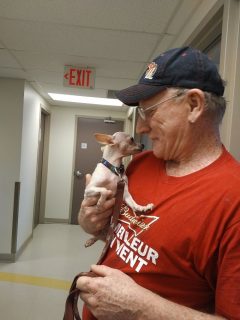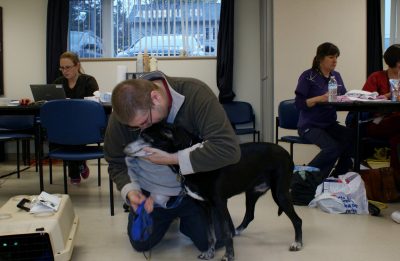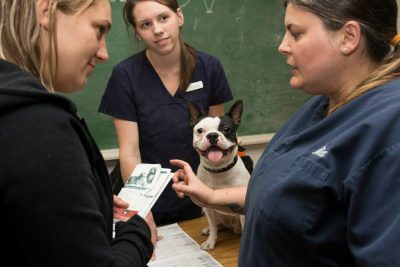 By Miski Dahir & Jyllenna Wilke
By Miski Dahir & Jyllenna Wilke
It’s been said that the best therapists have fur and four legs, and many individuals can provide anecdotal evidence for the healing power of animals. The idea of animals playing a role in human health and well-being has been frequently found in literature and popular culture. In many homes and communities, poor animal welfare is often indicative of poor human welfare, and there is also a link between animal abuse and family violence. The scientific community is also beginning to explore the links between animal and human welfare. Researchers have explored the idea of zoonosis, diseases which can be transmitted to humans from animals. But they are increasingly considering zooeyia, which refers to the positive impact that relationships with animals can have on human health. The concept of One Health considers how humans, animals, and the environment interact to affect human health. The framework of One Health can be utilized to explore how the welfare of animals is related to human welfare as well as how their environmental (or community) can enhance this relationship .
.
Biophilia, the connection an organism has with other living organisms in nature, is viewed as a basic, biological human need. Isolation and disconnect can result in negative consequences for the health of humans—mentally, physically, and spiritually. In contrast, connection and a sense of belonging can be indicators of good human health. Animals can meet the need for a connection to the natural world, and by doing so, they can improve the health of humans. One study demonstrated that a dog gazing at its owner significantly increased levels of oxytocin, a hormone responsible for feelings of attachment and happiness, in the owner. This increase in oxytocin could be indicative of one mechanism by which companion animals can improve human health. Other studies indicate that pets appear to improve the quality of life for vulnerable youth by reducing the use of drugs and number of arrests. Often the youth reduced their drug use in order to be able to provide a better quality of life for their pets. These studies support the idea that pets provide youth with stability and responsibility while also teaching them about unconditional love and trust.
More and more research is emerging on the positive effects of human-animal interactions. It appears that pets could be an effective way of helping people from more vulnerable and socially marginalized populations? Yet, understanding the needs of individuals from the populations sometimes requires looking at the world from their perspective, rather than through the administration of rating scales and surveys. Different methodologies can assess needs and impact while also providing opportunities for the individuals to feel comfortable  and empowered in their participation in the research. One such methodology is photovoice.
and empowered in their participation in the research. One such methodology is photovoice.
Photovoice is a method that uses photography to allow participants to share their views and use it to enhance their community. According to Wang and Burris (1997), photovoice aims to achieve three goals: a) to allow people to record and reflect on their community’s strengths and concerns, b) to use photography to discuss and critically think about important issues in the community, and c) to forward this information onto policy makers. The process involves providing members of a community with a camera and allowing them to capture images of their community, environment, and everyday health. Participants discuss their photographs with one another, and share them with researchers, policy makers and other community members.
As a qualitative research method, the photovoice method has many useful applications. Photovoice allows researchers to have insights as to how a group of people may perceive the world around them. Photovoice is often used in health research with participants from marginalized populations and youth. The photovoice method allows all members of a group to participate and have a voice as long as they are able to learn to use a camera. It is inclusive and does not require participants to be able to read and write. As a result, it is an effective tool in giving a voice to members of marginalized populations who might feel reluctant or disempowered when pushed to communicate to people perceived to be in positions of power, such as researchers. Furthermore, the photovoice method allows participants to share their thoughts on their community and the world around them through a visual representation. As is often said, a picture can be worth a thousand words. This visual representation allows participants to share and document the world around them using a powerful mode. The photovoice method is also effective for people from cultures where storytelling is a traditional method of conveying information, beliefs and values. The use of photovoice as a research method not only gives participants the opportunity to be listened to, but it can also foster trust and social support.
Our Pets and Our Health: A photovoice pilot study will be looking at the impact of pet ownership on the health of vulnerably housed and homeless people in Ottawa, Ontario through the lens of One Health. Our goal for this research is to understand the perception of pets among this population including what motivates pet ownership and the perceived benefits and costs of owning a pet.
This study will be conducted in partnership with Community Veterinary Outreach. This organization provides pro bono animal care to individuals that may not be able to access health care for their pets. Services include vaccinations, spay and neuter, and general check-ups. Additionally, services to enhance human health are also provided, including dental services, support for those living with HIV, and programs to assist with quitting smoking. For many individuals that use the Community Veterinary Outreach service, they would not otherwise be able to access these human health care services. In this way, the clinic embodies the One Health initiative, by directly linking the health of human owners with the health of their pets.
This study has implications to the One Health research as well as policies of organizations working with homeless and vulnerably housed individuals. Our research is further exploring the concept of zooeyia, and it could open doors for further partnerships between animal health and human health professionals. If the research findings support a link between human and animal health and welfare in this population, this could encourage policy changes in organizations working with these individuals. Some changes could include increasing the number of pet-friendly shelters and housing operations, as well as increasing access to affordable animal care. Organizations might also consider the use of animal assisted therapy for client support.
Sources:
Chalmers, Darlene & Dell, Colleen Anne. (2015). Applying One Health to the Study of Animal-Assisted Interventions. Ecohealth, 12(4), 560-562.
Dell, Colleen & Anna Belle. (2015). Questioning “Fluffy”: A Dog’s Eye View of Animal-Assisted Interventions (AAI) in the Treatment of Substance Misuse. Subst Use Misuse, 50(0), 1148-1152.
Hodgson, Kate & Darling, Marcia. (2011). Zooeyia: An essential component of “One Health.”CVJ, 52, 198-191.
Kelly K.J. (2016). Photovoice Capturing American Indian Youths’ Dietary Perceptions and Sharing Behavior-Changing Implications. Social Marketing Quarterly. 23(1), 64-79.Jordan, Tyler & Lem, Michelle. (2014). One Health, One Welfare: Education in practice: Veterinary students’ experiences with Community Veterinary Outreach. CVJ, 50, 1203-1206.
Lem, Michelle, et al. (2013). Effect of Companion Animal Ownership among Canadian Street-involved Youth: A Qualitative Analysis. Journal of Sociology & Social Welfare, 40(4), 285-304.
Wang, C.& Burris, M. (1997). Photovoice: Concept, methodology, and use for participatory needs assessment. Health Education and behavior. 24(3), 369-387.
Wang, C., Cash J.L, Powers L.S. (2000). Who Knows the Streets as Well as the Homeless? Promoting Personal and Community Action Through Photovoice. Health Promotion Practice. 1(1), 81-89.